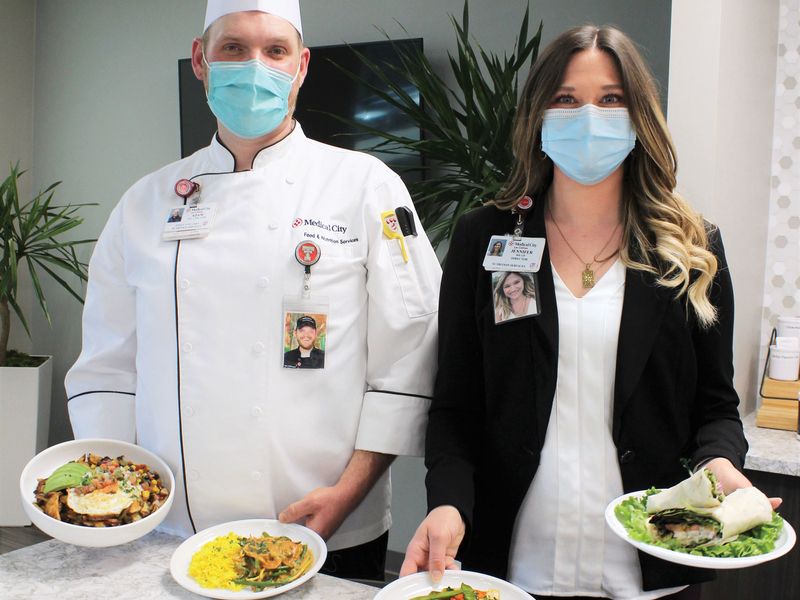 MEDICAL CITY HEALTHCARE
MEDICAL CITY HEALTHCARE
Adam Schloemer, executive chef at Medical City Las Colinas, and Jennifer Ballance, food and nutrition services director, Medical City Las Colinas, present dishes created as part of the health system’s recent effort to update its menus with meals that cater to diverse patient populations.
The goal of being more inclusive has prompted many hospitals to re-examine many facets of a patient’s stay.
From clinical staff diversity and cultural sensitivity training to the design of inpatient rooms and lobbies, the pursuit of building stronger relationships with increasingly diverse communities can mean constantly reviewing and redefining what constitutes a “patient-centered experience.”
Such efforts are at the heart of Dallas-based Medical City Healthcare’s attention to their menu offerings.
“One of the things we really pride ourselves on is we care like family,” said Mary Ann Moser, division director of food and nutrition services for Medical City. “So why not include some of those family-type recipes that our patients are used to, to make them feel more comfortable when they are in a hospital environment.”
Late last year, Moser gathered the health system’s executive chefs, food service directors and dietitians to work on developing recipes that could meet both nutritional and cultural needs of patients.
Chefs contributed their expertise in Middle Eastern, Asian, Indian and Mexican cuisines, as well as an array of vegetarian, vegan and Southern U.S.-style dishes.
Each recipe was analyzed to understand its nutritional value, then they were modified to maintain certain dietary guidelines, Moser said.
Staff was then invited to try each meal to review not just its tastiness but its authenticity.
None of that could have been possible without staffers having diverse backgrounds.
In fact, hospital staff contributed recipes based on family dishes.
All meals are prepared within Medical City’s 14 scratch kitchens across 16 hospitals, which Moser said allows food service providers at a particular site to tailor a menu to meet the needs of a specific patient population.
Purchasing contracts with various local fresh food distributors allow the made-to-order approach to be less expensive compared with using a contracted food service company. They also allow greater flexibility in terms of how meals are served. Several hospitals offer patients a room service option, Moser said.
Of course Medical City’s culinary initiative isn’t the first.
Patients staying at Holy Name Medical Center in Teaneck, N.J., are served food from their native culture and have access to television and newspapers in their native language, as part of the hospital’s Asian Health Services program.
Those details can make a difference in a patient’s overall experience and satisfaction with a hospital and establish greater trust in the clinical services they receive.
Patient perceptions about the quality of their food service have been recognized for years as having a huge impact on their overall level of satisfaction with a hospital stay. A 2017 study that examined the impact of introducing more of a patient-centered food service model to hospitals in Australia found that it led to higher patient satisfaction, including increased nutritional intake, reduced plate waste, and a 15% decline in patient meal costs compared with a traditional food service model.
Improved satisfaction also can contribute to better communication between clinicians and patients, which can then promote greater medical adherence and improved health outcomes, said Cordialis Msora-Kasago, regional nutrition manager for food service management provider Sodexo and national spokesperson for the Academy of Nutrition and Dietetics.
“Food is one of the things that when people come into a hospital is the most familiar to them—it is comfort, it is care, it is home at a time when they feel most vulnerable,” Msora-Kasago said. “Cultural food preferences actually play a role in terms of how well a patient heals because if it is something that is familiar to them, they are more likely to eat it.”
Msora-Kasago said it can be challenging to create meals that are both culturally inclusive and therapeutic, given that a single substitute ingredient can in some cases change the entire complexity and taste of a popular dish.
She said the shift toward offering meals that are more culturally appropriate at hospitals is an idea that has taken hold among some of the large, multinational food service management firms that can utilize their size and resources to bring more authenticity to the meals patients eat.
“Patients want to be satisfied with their meals, and providing a meal that is as close as possible to home is essential,” Msora-Kasago said.
Source link : https://www.modernhealthcare.com/providers/giving-patients-taste-home











